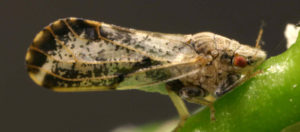By Cam Petersen, Food Policy and Sustainability Leadership Certificate student
This blog is part of a series from the December Arizona Immersive program of the Food Policy and Sustainability Leadership Graduate Certificate Program. Students virtually toured the state, meeting with farmers, ranchers, entrepreneurs, government staff and non-profit leaders.
The practice of quarantining is anything but new to Melanie Galvan. As a Plant Protection and Quarantine (PPQ) Officer at the U.S. Department of Agriculture’s (USDA) Animal and Plant Health Inspection Service (APHIS), she’s used to wearing protective gear and preventing the spread of plant pests and disease. This fall, our Food Policy and Sustainability Leadership cohort took a virtual trip to Arizona where she walked us through different procedures for inspecting items soon to be exported outside of the U.S.
Never heard of APHIS or the PPQ program? APHIS is a multi-faceted agency with a broad mission area that includes protecting and promoting U.S. agricultural health, regulating genetically engineered organisms, administering the Animal Welfare Act, and carrying out wildlife damage management activities. Within APHIS is a program called Plant Protection and Quarantine, which safeguards U.S. agriculture and natural resources against the entry, establishment, and spread of economically and environmentally significant pests, and facilitates the safe trade of agricultural products.
The idea of quarantining plants is foreign to most people who haven’t travelled internationally or taken a vacation to Hawaii, but in theory it’s pretty straightforward. Federal regulations require that plants and seeds enter the U.S. through designated ports of entry. PPQ officers operate plant inspection stations for the examination and clearance of those items. The main goal is to prevent the spread of plant pests and noxious weeds, both within this country and abroad.
Melanie played a number of videos during our virtual meeting that helped explain a few processes PPQ officers regularly perform. In one video, she takes us inside a large refrigerated warehouse (called a “cooler”) at a retail farm facility where she demonstrates a typical inspection. Before entering the facility, she inventories the protective gear she is required to don: hairnet, hardhat, gloves, long sleeve jacket, safety vest. There’s also a hand and boot sanitizer station at the door. I have to admit, these measures would have elicited more of a response in me prior to COVID-19 and the now ubiquitous practice of sanitizing your hands every time you enter a building. Nevertheless, it's obvious that this is a process that PPQ officers take very seriously. Inside the cooler and at her isolated (another familiar concept) inspection table, Melanie shows us her tools and demonstrates an inspection of a sample of romaine grown in California and destined for export to Mexico. Her tools are fairly ordinary -- a flashlight, a handheld magnifying glass called a loupe, vials for collecting samples -- but one can easily appreciate the utilitarian nature of each one. Using the “tapping method” she yields a few insects that are deftly collected into a glass vial.
Any living insects found on a sample must be sent to a PPQ entomologist for further inspection. These experts utilize high power microscopes, vast database catalogues, and their own knowledge to accurately identify any specimens. The process is meticulous and vetted by a system of seniority and previously accurate identifications, leaving little room for error.
Mexico, like almost every country that imports plants and plant products, has a list of insects, fungi, and diseases that are prohibited from entering the country. If all goes well and the insects found on the sample are not on the list of prohibited pests, the PPQ officer can issue a phytosanitary certificate. These are issued to indicate that plants and plant products meet specified import requirements. Phytosanitary certificates are not mandatory to export plants and plant products from the U.S., but these certificates are issued to assist exporters in meeting the plant quarantine requirements and they aid the process of importing and exporting crops in the global economy.
At this point, you might be asking yourself why anyone would jump through so many hoops to make sure certain insects aren’t getting a free trip abroad? Let’s look at the introduction of the Asian Citrus Psyllid (ACP), to take one example that has had grave implications for Arizona. ACP was first detected in Florida in 1998, then spread to Texas in 2001, California in 2008, and Arizona in 2009. ACP is now present in all citrus growing regions of the United States, and while the insect itself causes little direct feeding damage, it can carry the bacteria that causes huanglongbing (also known as “citrus greening disease”). The California Department of Food and Agriculture estimates potential damage at $224 million annually for the state if the spread of the disease is left unchecked. Arizona, itself a significant citrus producer, sits squarely inside the sights of this petulant pest. Introducing biological controls to reduce ACP populations is one of the many priorities that falls under APHIS’ umbrella.
Although the COVID-19 pandemic will surely pass and we may one day be able to lift our practice of self-quarantine, the work of APHIS and the PPQ program will not come to a halt. As the world continues its steady stride towards globalization we will perpetually face the spread of insects and disease through agricultural commodities. The work of Melanie Galvan and her fellow officers at APHIS is incredibly important for the wellbeing of agriculture, the environment, and the economy the world over. So next time you peel an orange, think about the PPQ program and the rigorous process that ensures that we can keep growing healthy productive crops throughout the U.S.

